Freestyle BMX
Freestyle BMX is a creative way of using bicycles originally designed for bicycle motocross racing. It can be split into several disciplines, although riders will generally participate in more than one discipline. These are Street, (skate)Park, Vert, Trails and Flatland. Rather confusingly, in competitions, park riding is often referred to as 'Street'.
Street
Street riding occurs on public streets or private property, typically within cities and towns. Without purpose-made ramps, riders have to improvise with banks, walls, rails, gaps, etc. In fact, almost anything can be used as an obstacle, and it is precisely this that draws people to street riding. Riders enjoy street riding because they are not constrained to what a skatepark designer has planned for them to ride, so it allows a good deal of creativity. Street riding relentlessly progresses, with obstacles and tricks that were considered too big or technical to attempt, becoming common place.


Many professional BMXers are street riders who are employed for the exposure they get through video parts and magazines, rather than for their competition results. However, these riders generally don't get paid the huge sums that the big competition riders get, as most of the big money comes from placing in events such as the X Games. However, riders like Van Homan, who is a progressive street rider, often enter the X Games and manage to place quite high.
Street bikes are different from those used on park or dirt. Typically they will have two or four stunt (axle) pegs for grinding. They are usually the heaviest and strongest type of BMX bike. A considerable number of street riders set up their bikes without hand brakes (popularized by riders such as New York's Edwin DeLaRosa).
Some street riders may also ride park and dirt, but the set up of street bikes can make the latter difficult.
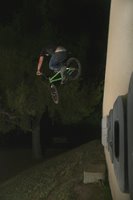
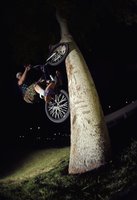

Park
Skateparks are used by BMXers as well as skateboarders, and both draw inspiration from the other. Skateparks themselves can be made of wood or concrete, or in the case of local council-supplied parks, metal.
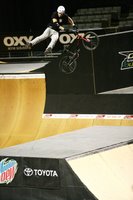
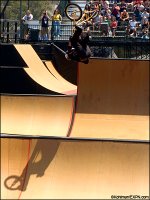

Styles of riding will differ between wood and concrete parks - wood lends itself to technical tricks, while concrete is more suited to a fast, flowing style, with riders searching for gaps, and aiming to air higher from the coping. However, it is not unusual for riders to merge the two styles in either type of park.


Concrete parks are commonly built outdoors due to their ability to withstand years of exposure to the elements. Concrete parks are also often publicly funded due to their permanent and costly nature. Parks made from wood are popular with commercial skateparks due to ease of construction, availability of materials, cost, and the relative safety associated with falling on wood instead of concrete. Parks designed with BMX use in mind will typically have steel coping that is less prone to damage than concrete or pool coping.

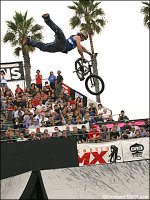
Common obstacles include:
quarter pipes - literally, quarter of a pipe - riders air from it and perform tricks on a platform above the ramp
spines - two quarter pipes back to back
flat banks - a flat bank set at an angle of roughly 40 degrees from horizontal
wall rides - a vertical wall above either quarter pipes or flat banks
miniramps - two small quarter pipes facing one another, like a halfpipe, but with a short flat area between.
hips - essentially two quarter pipes or flat banks, each with one edge at a right angle to the other.

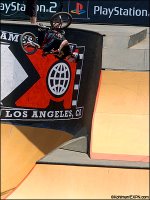
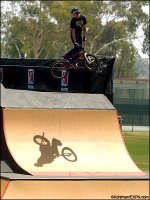
Vert
Perhaps the most extreme of the BMX disciplines, a Vert ramp consists of two quarter pipes set facing each other (much like a mini ramp), but at around 10-13 feet tall (around 2.5 to 3 metres) high. Both 'faces' of the ramp have an extension to the transition that is vertical, hence the name.

Riders go up each face, performing tricks in the air before landing into the same face. A typical run involves going from one side to the other, airing above the coping each side. Also possible are 'lip tricks' - tricks on the platform at the top of the ramps before dropping into the ramp.
Mat Hoffman popularised the sport in the early 90s, and holds the record for the highest jump of 27' out of a 25' ramps (a total of over 15.5 metres from the ground). He achieved this by being dragged along a field by a friend with a motorbike and hitting one face of the ramp. On one attempt, he lost control at the peak of his jump, and the resulting crash caused life-threatening injuries such as losing his spleen. Remarkably, despite his age and injuries in the past, he still competes to this day.
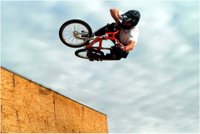
The danger of the discipline (and scarcity of full-size vert ramps) puts most riders off, and as such, there are a small number of top professionals who remain at the top of the sport for many years. Most notable are Dave Mirra (US) and Jamie Bestwick (UK) who have won almost all the major international competitions in the past 5 years.


Trails
Trails are, as the name suggests, lines of jumps built from dirt (heavily compacted mud). The jumps consist of a steep take off, called a lip, with an often slightly less steep landing. The lip and landing are usually built as separate mounds, divided by a gap. The gap is measured from the topmost part of the lip, horizontally to the topmost part of the far side of the landing. Gaps typically range from only a couple of feet to over twenty feet. A moderate gap is around twelve feet.

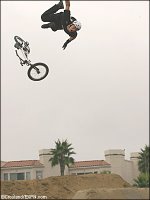
Trails riding is sometimes also referred to as Dirt Jumping. Many maintain that a subtle difference exists in the approach of the rider; trails riders focus more on flowing smoothly from one jump to the next whilst performing more stylish tricks, while dirt jumpers try to perform the craziest tricks they can without much thought to their style or smoothness.
Although many regard trails and street as being completely opposite, the attraction is similar—trails riders build their own jumps so their riding is limited only by their creativity and resourcefulness.
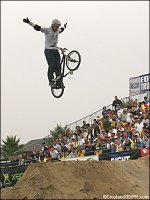
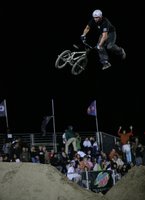
Dirt jumping bikes are heavier than bmx racing bikes but lighter than freestyle bikes. Often times a bmx jump bike will have only a rear brake and they might also sport a gyro. The gyro will allow them to do airborne tricks such as barspins.



Flatland
Flatland BMX occupies a position somewhat removed from the rest of freestyle bmx. People who ride in the above disciplines will generally take part in at least one of the others, but flatlanders tend to only ride flatland. They are often very dedicated and will spend several hours a day perfecting their technique.
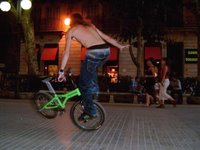
Flatland also differs from the others in that the terrain used is nothing but a smooth, flat surface (e.g. an asphalt parking lot, basketball courts, etc.). Tricks are performed by spinning and balancing in a variety of body and bicycle positions. Riders almost always use gnurled aluminum pegs to stand on to manipulate the bike into even stranger positions.
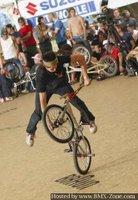
Flatland bikes typically have a shorter wheelbase than other freestyle bikes. F;at;and bikes differ from dirt jumping bikes and freestyle bikes in one way. The frames are often more heavily reinforced due to the fact that the people riding flatland often stand on the frames. This shorter wheelbase requires less effort to make the bike spin or to position the bike on one wheel. One of the primary reasons flatlanders often ride only flatland is a result of the decreased stability of using a shorter bike on ramps, dirt and street.

A variety of options are commonly found on flatland bikes. The most unifying feature of flatland bikes is the use of four pegs, one on the end of each wheel axle. Flatland riders will choose to run either a front brake, a rear brake, both brakes, or no brakes at all, depending on stylistic preference.
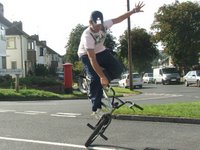

Street
Street riding occurs on public streets or private property, typically within cities and towns. Without purpose-made ramps, riders have to improvise with banks, walls, rails, gaps, etc. In fact, almost anything can be used as an obstacle, and it is precisely this that draws people to street riding. Riders enjoy street riding because they are not constrained to what a skatepark designer has planned for them to ride, so it allows a good deal of creativity. Street riding relentlessly progresses, with obstacles and tricks that were considered too big or technical to attempt, becoming common place.


Many professional BMXers are street riders who are employed for the exposure they get through video parts and magazines, rather than for their competition results. However, these riders generally don't get paid the huge sums that the big competition riders get, as most of the big money comes from placing in events such as the X Games. However, riders like Van Homan, who is a progressive street rider, often enter the X Games and manage to place quite high.
Street bikes are different from those used on park or dirt. Typically they will have two or four stunt (axle) pegs for grinding. They are usually the heaviest and strongest type of BMX bike. A considerable number of street riders set up their bikes without hand brakes (popularized by riders such as New York's Edwin DeLaRosa).
Some street riders may also ride park and dirt, but the set up of street bikes can make the latter difficult.



Park
Skateparks are used by BMXers as well as skateboarders, and both draw inspiration from the other. Skateparks themselves can be made of wood or concrete, or in the case of local council-supplied parks, metal.



Styles of riding will differ between wood and concrete parks - wood lends itself to technical tricks, while concrete is more suited to a fast, flowing style, with riders searching for gaps, and aiming to air higher from the coping. However, it is not unusual for riders to merge the two styles in either type of park.


Concrete parks are commonly built outdoors due to their ability to withstand years of exposure to the elements. Concrete parks are also often publicly funded due to their permanent and costly nature. Parks made from wood are popular with commercial skateparks due to ease of construction, availability of materials, cost, and the relative safety associated with falling on wood instead of concrete. Parks designed with BMX use in mind will typically have steel coping that is less prone to damage than concrete or pool coping.


Common obstacles include:
quarter pipes - literally, quarter of a pipe - riders air from it and perform tricks on a platform above the ramp
spines - two quarter pipes back to back
flat banks - a flat bank set at an angle of roughly 40 degrees from horizontal
wall rides - a vertical wall above either quarter pipes or flat banks
miniramps - two small quarter pipes facing one another, like a halfpipe, but with a short flat area between.
hips - essentially two quarter pipes or flat banks, each with one edge at a right angle to the other.



Vert
Perhaps the most extreme of the BMX disciplines, a Vert ramp consists of two quarter pipes set facing each other (much like a mini ramp), but at around 10-13 feet tall (around 2.5 to 3 metres) high. Both 'faces' of the ramp have an extension to the transition that is vertical, hence the name.

Riders go up each face, performing tricks in the air before landing into the same face. A typical run involves going from one side to the other, airing above the coping each side. Also possible are 'lip tricks' - tricks on the platform at the top of the ramps before dropping into the ramp.
Mat Hoffman popularised the sport in the early 90s, and holds the record for the highest jump of 27' out of a 25' ramps (a total of over 15.5 metres from the ground). He achieved this by being dragged along a field by a friend with a motorbike and hitting one face of the ramp. On one attempt, he lost control at the peak of his jump, and the resulting crash caused life-threatening injuries such as losing his spleen. Remarkably, despite his age and injuries in the past, he still competes to this day.

The danger of the discipline (and scarcity of full-size vert ramps) puts most riders off, and as such, there are a small number of top professionals who remain at the top of the sport for many years. Most notable are Dave Mirra (US) and Jamie Bestwick (UK) who have won almost all the major international competitions in the past 5 years.


Trails
Trails are, as the name suggests, lines of jumps built from dirt (heavily compacted mud). The jumps consist of a steep take off, called a lip, with an often slightly less steep landing. The lip and landing are usually built as separate mounds, divided by a gap. The gap is measured from the topmost part of the lip, horizontally to the topmost part of the far side of the landing. Gaps typically range from only a couple of feet to over twenty feet. A moderate gap is around twelve feet.


Trails riding is sometimes also referred to as Dirt Jumping. Many maintain that a subtle difference exists in the approach of the rider; trails riders focus more on flowing smoothly from one jump to the next whilst performing more stylish tricks, while dirt jumpers try to perform the craziest tricks they can without much thought to their style or smoothness.
Although many regard trails and street as being completely opposite, the attraction is similar—trails riders build their own jumps so their riding is limited only by their creativity and resourcefulness.


Dirt jumping bikes are heavier than bmx racing bikes but lighter than freestyle bikes. Often times a bmx jump bike will have only a rear brake and they might also sport a gyro. The gyro will allow them to do airborne tricks such as barspins.



Flatland
Flatland BMX occupies a position somewhat removed from the rest of freestyle bmx. People who ride in the above disciplines will generally take part in at least one of the others, but flatlanders tend to only ride flatland. They are often very dedicated and will spend several hours a day perfecting their technique.

Flatland also differs from the others in that the terrain used is nothing but a smooth, flat surface (e.g. an asphalt parking lot, basketball courts, etc.). Tricks are performed by spinning and balancing in a variety of body and bicycle positions. Riders almost always use gnurled aluminum pegs to stand on to manipulate the bike into even stranger positions.

Flatland bikes typically have a shorter wheelbase than other freestyle bikes. F;at;and bikes differ from dirt jumping bikes and freestyle bikes in one way. The frames are often more heavily reinforced due to the fact that the people riding flatland often stand on the frames. This shorter wheelbase requires less effort to make the bike spin or to position the bike on one wheel. One of the primary reasons flatlanders often ride only flatland is a result of the decreased stability of using a shorter bike on ramps, dirt and street.

A variety of options are commonly found on flatland bikes. The most unifying feature of flatland bikes is the use of four pegs, one on the end of each wheel axle. Flatland riders will choose to run either a front brake, a rear brake, both brakes, or no brakes at all, depending on stylistic preference.




0 Comments:
Post a Comment
Subscribe to Post Comments [Atom]
<< Home